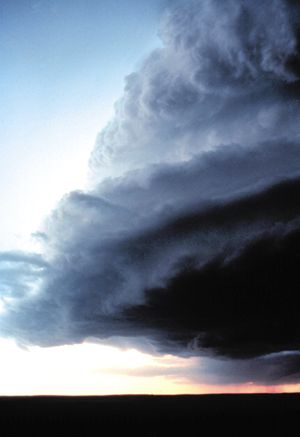|
|
 |
| SW Aviator Magazine is available in print free at FBOs and aviation-related businesses throughout the Southwest or by subscription. |

|
 |

|
 |
 |
 |
|
The web's most comprehensive database of Southwest area aviation events.
|

|
 |

|
 |
|
Featured Site:
|
|
|
 |
|
A continuosly changing collection of links to our favorite aviation related web sites.
|

|
 |

|
 |

|
 |
Search by:

|
|
|
Or enter a keword:

|
|
|
Post a FREE Classified Ad 
|
 |
|

|
Cloud Clearance Requirements
|
|
Why All Those #*#%* Numbers?
|

By John Lorenz
Believe it or not, the cloud clearance and visibility minimums for VFR flying that we all had to learn (but have mostly forgotten) were not benignly formulated to prevent vertigo and control-loss accidents in VFR pilots who otherwise might be thick enough to wander into clouds. That is just a side benefit. Rather, the main purpose of these rules is to provide a visual buffer zone, where an IFR aircraft popping out of a cloud and a VFR aircraft flying near that cloud should have time to see, maneuver, and avoid each other.
IFR aircraft are rigidly separated from each other by the dictator system, where ATC reigns supreme. In contrast, VFR traffic stays clear of other VFR traffic by the anarchy system: "every pilot see and avoid." These two largely incompatible systems don’t overlap much, since most IFR traffic flies higher than most VFR traffic. That’s good, because things get interesting where they do overlap. ATC will often point out VFR traffic to an IFR aircraft under their control, but that is not their primary responsibility. ATC’s main task is to keep those aircraft that are using the IFR system, and only those aircraft, separated from each other.
So how are IFR and VFR aircraft supposed to keep out of each other’s hair? No problem within clouds where only IFR traffic ventures. The solution for separation outside of clouds is the ever-popular VFR cloud-clearance and visibility requirements, and the associated admonition for everyone, VFR and IFR, to keep a sharp lookout. If this seems like a lame solution, consider that the alternative is more regulation, and be happy. Of course, there is the mandated 500 foot difference between VFR and IFR cruising altitudes, and the hemispherical rule about cruising altitudes (which don’t apply when climbing and descending or within 3000 feet of the ground), but some VFR pilots, to their detriment, tend to be careless about these.
Controlled, class E airspace comprises most of the US airspace below 18,000 ft. Within this airspace below 10,000 ft MSL, VFR traffic is required to have at least 3 miles visibility and to stay a certain distance away from clouds. It was rarely obvious when we learned these rules, but these dimensions are related to the speeds of typical big aircraft. ATC wants a jet in cruise to have at least 2000 ft after it pops out of the side of a cloud to see and dodge a VFR aircraft. At 250 kts it takes only five seconds to cover 2000 ft: not much margin here. Jets climb like banshees but descend at more sedate rates, thus the greater vertical clearance requirement (1000 ft) above than below (500 ft) a cloud.
The increase in minimum cloud-clearance distances above 10,000 ft MSL (to a mile laterally and 1000 ft above and below the clouds) seems arbitrary until you make the connection that the 250-kt airspeed limitation is lifted above 10,000 ft. The visibility requirement increases to 5 miles at this altitude for the same reason. One mile away from a cloud really isn’t much given the cruise speeds of jets, so everyone flogging around above 10,000 ft is also required to have a transponder.
ATC doesn’t care what VFR traffic is doing below 1200 ft AGL because IFR aircraft don’t fly that low en route. Most of this airspace is left over as uncontrolled, class G airspace. VFR traffic in this airspace is free to dance around merely "clear of clouds" (there at last is the nod to keeping us safe from vertigo) and with a ridiculously low minimum visibility of one mile. IFR pilots can even fly inside the clouds in G airspace without talking to ATC, though prudence suggests they should be climbing. The class G airspace minimums go up at night to the same minimums used in class E airspace.
ATC wants a reasonable probability of visual IFR-VFR traffic separation over uncontrolled airports that have IFR approaches. Therefore, the floor of controlled, class E airspace, along with it’s higher clearance and visibility requirements, has locally been pushed down to displace some or all of the uncontrolled class G airspace around those airports. The floor of the controlled airspace is lowered from the normal 1200 ft AGL down to 700 ft AGL, or even to the surface, as indicated by the shaded and dashed magenta lines respectively on sectional charts.
The cloud-clearance requirements for VFR traffic in the class C and D airspace at controlled airports are the same as in the class E airspace, but in the more highly controlled class B airspace surrounding the busiest airports the requirements are actually reduced. Both VFR and IFR traffic are required to be talking to ATC in this airspace, and therefore everyone is playing by basically the same rules. Close scrutiny with radar also helps with traffic separation. Nevertheless, ATC sometimes forgets that not all their traffic is IFR, so if you’re a VFR pilot flying in such airspace you must speak up and decline vectors that will take the aircraft into clouds. And targets can slip by ATC, so clear your turns, heads up, and eyeballs clicking. Whether VFR or IFR, in clear air that’s the central component of your anti-collision system.
|
Click here to return to the beginning of this article.  |
|